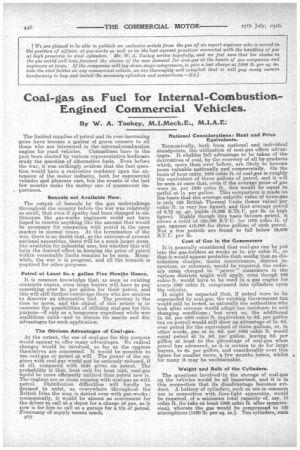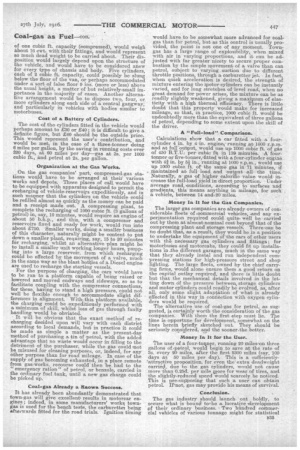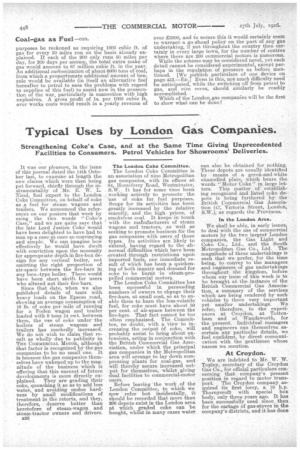Coal-gas as Fuel for Internal-Combustion Engined Commercial Vehicles.
Page 6

Page 7

Page 8

If you've noticed an error in this article please click here to report it so we can fix it.
By W. A. Tookey, M.I.Alech.E.,
• The limited supplies of petrol and its ever-increasing price have become a Ipatter of grave concern to all those who are interested in the internal-combustion engine for road vehicles. Committees have in the past been elected by various representative bodiesato study the question of alternative fuels. Even before the war, it was strikingly evident that the fuel question would have a restrictive tendency upon the extension of the motor industry, both for commercial vehicles and pleasure cars, but the events of the last few months make the matter one of paramount importance.
Benzole not Available Now.
The output of benzole by the gas undertakings throughout the country before the war was relatively so small, that even if apathy had been changed to enthusiasm the gas-works engineers could not have hoped to recover anything like the amount that would be necessary for competing with petrol in the open market in normal times. At the termination of the war, there is no doubt that, as the outcome. of present national necessities, there will be a much larger quantity available for industrial uses, but whether this will have the desired effect in keeping the price of petrol within reasonable limits remains to be seen. Meanwhile, the war is in progress, and all the benzole is required for other purposes.
Petrol at Least 2s. a gallon Five Months Hence.
It is common knowledge that as soon as existing contracts expire, even large buyers will have to pay something over 2s. per gallon for their petrol, and this-will still further encourage those who are anxious to discover an alternative fuel. The present is the time to move, and the object of this article is to examine the possibilities of utilizing coal-gas for this purpose—if only as a temporary expedient while war conditions exist—and to discuss its merits and disadvantages for such application.
The Obvious Advantages of Coal-gas.
At the outset, the use of coal-gas for this purpose would appear to offer many advantages. No radical changes would be involved, so far as the engines themselves are concerned. It would be 'possible to use coal-gas or petrol at will. The power of the engines with coal-gas would not be seriously reduced, if at all, compared with that given on petrol. The probability is that, heat unit for heat unit, coal-gas would be more efficiently utilized than petrol now is. The engines are as clean running with coal-gas as with petrol. Distribution difficulties will hardly be deemed to exist, as everywhere throughout the British Isles the map is dotted over with gas-works ; consequently, it would be almost as convenient for the driver to call at a depot for a charge of gas, as it now is for him to call at a garage for a tin of petrol. Frequency of supply means much.
na0
National Considerations: Heat and Price Equivalents.
Economically, both from national and individual standpoints, the utilization of coal-gas offers advantages. It efiables full advantage to be taken of the derivatives of coal, by the recovery of all by-products which, more than ever before, are likely to become more valuable nationally and commercially. On the basis of heat units, 1000 cubic ft. of coal-gas is roughly the equivalent of three gallons of petrol, and it will be seen at once that, even if the average price of gas were as. per 1000 cubic ft., this would be equal to peti.ol at is. per gallon. This comparison is made on the basis that the average calorific value of town-gas is only 420 British Thermal Units (lower value) per cubic ft. (a very low figure), and that average petrol of 0.72 sp. .gr. yields 10,000 B.Th.U. per lb. (a. high figure). Highly though this basis favours petrol, it shows a total of 420,000 B.T.U. for 1000 cubic ft. of gas, against 410,000 for three gallons of such petrol. Not a few petrols are found to fall below 19,000 B.T.U. per lb.
Cost of Gas in the Gasometers It is generally considered that coal-gas can be put into the gas-holders at works at, 1s. per cubic ft. so that it would appear probable that., seeilig that no:distribution charges, mains maintenance, district inspectors, or salesmen, would be required, the ordinary rates charged to " power " consumers in the various districts inight well apply, even though 200 cubic. ft. would have to be used in a, gas engine for every. 1000 cubic ft. compressed into cylinders upon the vehicles.
It might be expected that, if petrol were to be superseded by coal-gas, the existing Government tax would still be levied, as naturally the authorities who look after revenue would adapt tax incidence to suit changing conditions ; but even so the additional
is. 6d. per 1000 cubic ft. (equivalent 6d. per gallon tax on petrol) would still show au advantage of Is. 6d. over petrol for the equivalent of three gallons, or, in other words, gas at 4s. 6d. per 1000 cubic ft. would equal petrol at Is. 6t1. per gallon, leaving 6d. per gallon at least to the advantage of " coal-gas when petrol has advanced, as it is certain to do for large buyers, to 2s. per gallon, and considerably over this figure for smaller users, a few months hence, whilst for many it may be unobtainable.
Weight and Bulk of the Cylinders.
The questions involved 'in the storage of coal-gas on the vehicles would be all important, and it is in this connection that its disadvantage becomes evident. A battery of cylinder, euch as are in common use in connection with .lime-light apparatus, would be required, of a minimum total capacity of, say, 10 cubic ft. (to take at least 1000 cubic ft. after compression), wherein the gas would be compressed to 120 atmespheres (1800 lb. per sq. in.). Ten cylinders, each
of one cubic ft. capacity (compressed), would weigh about 16 cwt. with their fittings, and would represent so much dead weight to be carried about. Their disposition would largely depend upon the structure of the vehicle, and would have to be considered anew for every type of chassis and body. Five cylinders, each of 2 cubic ft. -capacity, could possibly be slung below the floor of the van, or perhaps accommodated inider a sort of false floor 0 ins. (more or less) above the usual height, a matter of but relatively-small importance in the majority of eases. Another alternative arrangement would be to dispose two, four, or more cylinders along each side of a central gangway, and particularly in vehicles with bodies similar to motorbuses.
Cost of a Battery of Cylinders.
The cost of the cylinders fitted in the vehicle would perhaps amount to 230 or £40; it is difficult to give a definite figure, but £40 should be the outside price. This would represent the user's contribution, and would be met, in the case of a three-tormer doing 6 miles per gallon, by the saving in running costa over 320 days, at 60 miles per day—gas at 3s. per 1000 cubic ft., and petrol at 2s. per gallon.
Organization at the Gas Works.
On the gas companies' part, compressed-gas stations would have to be arranged at their various works and depots. These places of call, would have to be equipped with apparatus designed to permit the recharging of vehicle-reservoies expeditiously, and in such manner that the cylinders on the vehicle could be refillea almost as quickly as the money can be paid and a receipt made out. A compressing plant, to complete the recharging of 1000 cubic ft. (3 gallons of petrol) in, say,. 10 minutes, would require an engine of about 50 b.h.p., and this, with a compressor and reservoirs fixed and ready for work, would run into about £750. Smaller works, doing a smaller business of this character, naturally might be content to Pet down a smaller plant, requiring, say, 15 to 20 minutes for recharging, whilst an alternative 'plan might be to install a smaller unit working, longer hours, pumping into a large reservoir, from which recharging could be effected by the movement of a valve, much in the same way as the blast bottles of a Diesel engine are used to recharge the starting vessels.
For the purpose of charging, the cars would have to be run• to a platform capable of being raised or lowered and moved endways and sideways, so as to facilitate coupling with the compressor connections, for these, having to stand a high pressure, could not well be flexible enough to accommodate slight differences in alignment. With, this platform available, the charging could be expeditiously performed with a minimum of skill, whilst loss of gas through faulty handling would be obviated.
It will be obvious that the exact method of recharging decided upon will vary with each district according to local demands, but in practice it could be made as simple a matter as the present-day method of purchasing a tin of petrol, with the added advantage that no waste would occur in filling to the detriment of the purchaser, while the gas could -mot be misused for cleaning purposes, or, indeed, for any other purpose than for road mileage. In case of the supply of gas becoming exhausted, in a place remote from gas-works, recourse could then be had to the "emergency ration" of petrol, or benzole, carried in the ordinary fuel tank, until a new gas charge could be picked up.
Coal-gas Already a Known Success.
It has already been abundantly demonstrated that town-gas will give excellent results in motorcar engines; indeed, in some manufacturers' work e towngas is used for the bench tests, the carburetter being /deer-wards fitted for the road trials. Ignition timing
would have to be somewhat more advanced for coalgas than for petrol, but as this control is usually provided, the point is not one of any moment. Towngas has a large range of explosibility, when mixed with air in varying proportions and it can be adjusted with far greater nicety to i secure proper combustion by the simple movement of a valve than can petrol, subject to varying suction due to different throttle positions, through a carburetter jet.' In fact, when quick acceleration is desired, the strength of mixture entering the motor cylinders can be iustantly varied, and for long stretches of level road, when no great demand for power arises, the mixture can be as readily slightly weakened, giving a maximum of elasticity with a high thermal efficiency. There is little doubt that this property would make for increased mileage, so that, in practice, 1000 cubic ft. would be undoubtedly more than the equivalent of three gallons of petrol, depending to sore extent upon the skill of the driver.
A "Full-load" Comparison.
Calculations show that a ear fitted with a fourcylinder 4 in. by 'tin. engine; running at 1000 r.p.m. and at full output, would use up 1000 cubic ft. of gas a 450 B.T.U.: per cubic flit in 139 minutes. A' fourtonner or five-tonner,,fitted with a four-cylinder engine with 4i in. by 54 in. running at 1000 r.p.m., would use up 1000 cubic ft. Of the same gas in 71 minutes, if .. Maintained at full -load. arid •output all the time. Naturally, a. gas of higher .calorific value would in.crease the full-load Yield in direct proportion. Under average road,-conditions, according to surfaces and gradients, this means anything in mileage, for such a vehicle, between 14 and■20 miles.
Money In It for the Gas Companies.
The largpr gas companies are already owners of considerable fleets of icomnaercial vehicles, And arty experimentation required could quite t well be carried out by them at almost nominal cost beyond that of the compressing plant and storage vessels. There can be no doubt that, as a result, they would be in a position to undertake the equipment oTthe cars of other users with the nedessary gas cylinders and fittings • for motorbuses and motorcabs, they could fit up installations in _the different garages, much in the same way that they already instal and run independent' compressing stations for high-pressure street and shop lighting. The large fleets, owned by the chief carrying firms, would alone ensure them a good return on the capital outlay required, and there is little doubt but that the mechanical details involved in the letting down df the pressure between, storage cylinders and motor cylinders could readily be evolved, as after all, only some slight adaptation of what is already i effected n this way in connection with oxygen cylinders would be required. The alternative use of coal-gas for petrol, as suggested, is certainly worth the consideration of the gas companies. With them the first step must lie. The tune is opportune for' development, .somewhat on the lines herein briefly sketched. out. They should be seriously considered, and the sooner the better.
Money In It for the User.
The user of a four-tokner, running 20 inilewon three gallons of petrol, woulol begin to save at the rate of 3s. every 20 miles, after the first 5300 miles (say, 100 days at 50 miles per day). ThiS is a sufficiently'attractive proposition, for even the' extra deadweight carried, due to the gas cylinders, would nó l cause more than 0.25d. per mile wore for wear of tires, and the slightly-reduced speed would scarcely be noticed. This is ere-supposing that such -a user can obtain petroL If'not, gas may provide his means of survival.
Conclusion.
The gas industry should launch out boldly, to secure what is bound teebe a lucrative 'development of their ordinary business. Two hundred commercial vehicles of various tonnage might for statistical B35
purposes be reckoned as requiring 1000 cubic ft. of gas for every 30 miles run on the basis already explained. If each of the 200 only runs 50 miles per day, for 200 days per annum, the total extra make of gas would amount to 67 million cubic ft. in the year. An additional carbonization of about 6000 tons of coal, from which a proportionate additional amount of benzoic would be available (in itself an alternative fuel hereafter to petrol to ease the problems with regard to supplies of this fuel) to assist now in the prosecution of the war, particularly in connection with high explosives. A gross profit of .1s. per 1000 cubic ft. over works costs would result In a yearly revenue of
over 23000, and to secure this it would certainly seem to warrant a go-ahead policy on the part of any gas undertaking, if not throughout the country then certainly in every large town, for the number of centres where there are 209 commercial motors is numerous.
While the scheme may be considered novel, yet each detail cannot be considered experimental, except perhaps in the regulation of pressure as before mentioned. [We publish particulars of one device on page 453.—En.] Even in this, not much difficulty need 'be anticipated, while the switching off from petrol to gas, and vice versa, should similarly be readily accomplished. •
Which of the London. gas companies will be the first to show what can be done?






















